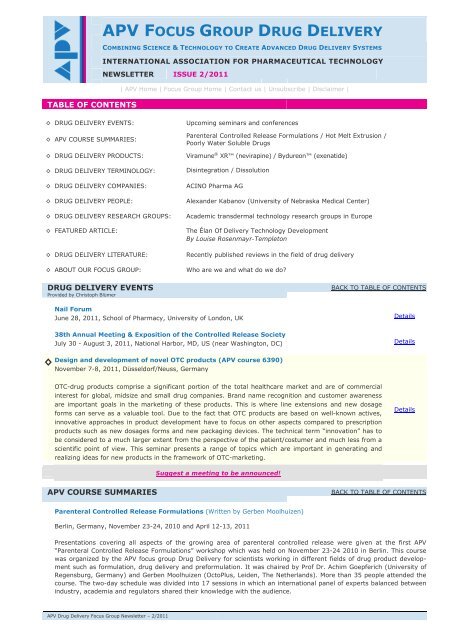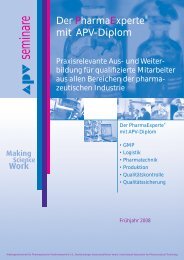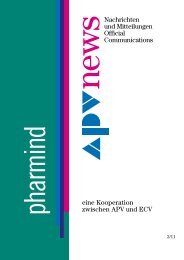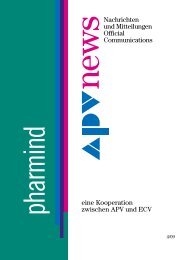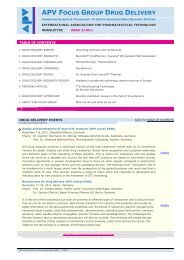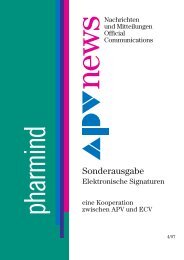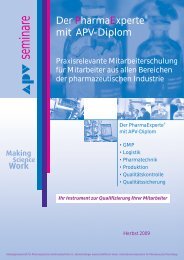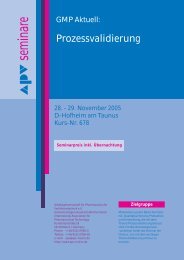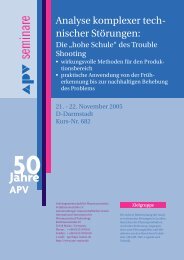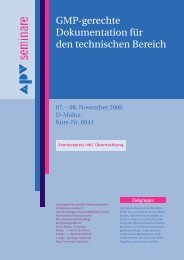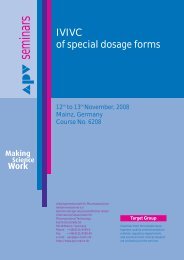APV FOCUS GROUP DRUG DELIVERY
APV FOCUS GROUP DRUG DELIVERY
APV FOCUS GROUP DRUG DELIVERY
Create successful ePaper yourself
Turn your PDF publications into a flip-book with our unique Google optimized e-Paper software.
TABLE OF CONTENTS<br />
<strong>APV</strong> <strong>FOCUS</strong> <strong>GROUP</strong> <strong>DRUG</strong> <strong>DELIVERY</strong><br />
COMBINING SCIENCE & TECHNOLOGY TO CREATE ADVANCED <strong>DRUG</strong> <strong>DELIVERY</strong> SYSTEMS<br />
INTERNATIONAL ASSOCIATION FOR PHARMACEUTICAL TECHNOLOGY<br />
NEWSLETTER ISSUE 2/2011<br />
| <strong>APV</strong> Home | Focus Group Home | Contact us | Unsubscribe | Disclaimer |<br />
◊ <strong>DRUG</strong> <strong>DELIVERY</strong> EVENTS: Upcoming seminars and conferences<br />
◊ <strong>APV</strong> COURSE SUMMARIES:<br />
Parenteral Controlled Release Formulations / Hot Melt Extrusion /<br />
Poorly Water Soluble Drugs<br />
◊ <strong>DRUG</strong> <strong>DELIVERY</strong> PRODUCTS: Viramune ® XR (nevirapine) / Bydureon (exenatide)<br />
◊ <strong>DRUG</strong> <strong>DELIVERY</strong> TERMINOLOGY:<br />
Disintegration / Dissolution<br />
◊ <strong>DRUG</strong> <strong>DELIVERY</strong> COMPANIES: ACINO Pharma AG<br />
◊ <strong>DRUG</strong> <strong>DELIVERY</strong> PEOPLE: Alexander Kabanov (University of Nebraska Medical Center)<br />
◊ <strong>DRUG</strong> <strong>DELIVERY</strong> RESEARCH <strong>GROUP</strong>S: Academic transdermal technology research groups in Europe<br />
◊ FEATURED ARTICLE: The Élan Of Delivery Technology Development<br />
By Louise Rosenmayr-Templeton<br />
◊ <strong>DRUG</strong> <strong>DELIVERY</strong> LITERATURE: Recently published reviews in the field of drug delivery<br />
◊ ABOUT OUR <strong>FOCUS</strong> <strong>GROUP</strong>: Who are we and what do we do?<br />
<strong>DRUG</strong> <strong>DELIVERY</strong> EVENTS BACK TO TABLE OF CONTENTS<br />
Provided by Christoph Blümer<br />
◊<br />
Nail Forum<br />
June 28, 2011, School of Pharmacy, University of London, UK<br />
38th Annual Meeting & Exposition of the Controlled Release Society<br />
July 30 - August 3, 2011, National Harbor, MD, US (near Washington, DC)<br />
Design and development of novel OTC products (<strong>APV</strong> course 6390)<br />
November 7-8, 2011, Düsseldorf/Neuss, Germany<br />
OTC-drug products comprise a significant portion of the total healthcare market and are of commercial<br />
interest for global, midsize and small drug companies. Brand name recognition and customer awareness<br />
are important goals in the marketing of these products. This is where line extensions and new dosage<br />
forms can serve as a valuable tool. Due to the fact that OTC products are based on well-known actives,<br />
innovative approaches in product development have to focus on other aspects compared to prescription<br />
products such as new dosages forms and new packaging devices. The technical term “innovation” has to<br />
be considered to a much larger extent from the perspective of the patient/costumer and much less from a<br />
scientific point of view. This seminar presents a range of topics which are important in generating and<br />
realizing ideas for new products in the framework of OTC-marketing.<br />
Suggest a meeting to be announced!<br />
Details<br />
Details<br />
Details<br />
<strong>APV</strong> COURSE SUMMARIES BACK TO TABLE OF CONTENTS<br />
Parenteral Controlled Release Formulations (Written by Gerben Moolhuizen)<br />
Berlin, Germany, November 23-24, 2010 and April 12-13, 2011<br />
Presentations covering all aspects of the growing area of parenteral controlled release were given at the first <strong>APV</strong><br />
“Parenteral Controlled Release Formulations” workshop which was held on November 23-24 2010 in Berlin. This course<br />
was organized by the <strong>APV</strong> focus group Drug Delivery for scientists working in different fields of drug product development<br />
such as formulation, drug delivery and preformulation. It was chaired by Prof Dr. Achim Goepferich (University of<br />
Regensburg, Germany) and Gerben Moolhuizen (OctoPlus, Leiden, The Netherlands). More than 35 people attended the<br />
course. The two-day schedule was divided into 17 sessions in which an international panel of experts balanced between<br />
industry, academia and regulators shared their knowledge with the audience.<br />
<strong>APV</strong> Drug Delivery Focus Group Newsletter – 2/2011 Page 1 of 15
Day 1<br />
After a brief introductory presentation by Gerben Moolhuizen on the commercial role and prospects for parenteral<br />
controlled release, Dr. Barbara Lueckel of F. Hoffmann-La Roche started the day. She first gave an overview of the<br />
beginnings of the field and provided an up-to-date overview of the various approaches available to achieve long term<br />
release of injectable drugs. The course then explored two technologies that are the historical backbone of the field in<br />
more detail. First, Prof Dr. Goepferich gave the audience an historic perspective of the most widely used polymer in the<br />
field, poly(lactide-co-glycolide), as well as a very good overview of the pros and cons of this polymer. Next, Prof. Dr.<br />
Karsten Maeder, Halle University, presented an overview of the field of liposomal formulations, the other backbone<br />
technology for controlled release that has resulted in a number of successful products.<br />
The program then moved to Prof Dr. Wim Hennink (Utrecht University, The Netherlands) who presented very interesting<br />
data on new polymers on the horizon. Dr. Karin Schoenhammer, Novartis, gave a presentation on in situ gelling.<br />
Dr. Christine Talling, (BayerSchering Pharma, Turku, Finland) focused her presentation on an area that have seen<br />
significant scientific and commercial success, namely non-biodegradable implantable systems. As the final speaker of<br />
Day 1, Prof. Dr. Robert Gurny (University of Geneva, Switzerland) engaged the audience with a talk on a field that hold<br />
a lot of promise and challenges: technologies for long term release of drugs in the eye. In his presentation, he covered<br />
recent, interesting work carried out by his group on a new injectable, biodegradable polymer for treatment of eye<br />
diseases. Day 1 ended with a panel discussion between speakers and attendees, which gave the audience a good opportunity<br />
to ask any questions they had.<br />
Day 2<br />
Day 2 of the program focused more on regulatory and development aspects, as well as on areas for future growth, such<br />
as long acting biopharmaceuticals. After introductory words from co-chair Prof. Dr. Goepferich, Dr. Ruud Verrijk<br />
(OctoPlus, The Netherlands) gave an inspiring presentation on getting a microsphere-product for the controlled release<br />
of interferon from the research bench to clinical proof-of-concept, giving insight into the practical issues to be overcome.<br />
He was followed by Dr. Sabine Hauck (Acino GmbH, Miesbach) who focused her presentation on the specific issues<br />
encountered when attempting to get regulatory approval for a generic injectable controlled release product. Her presentation<br />
was nicely complemented by the next, in which Dr. Katrin Buss from the German regulatory agency, BfArM,<br />
presented the regulatory requirements for depot formulations and biopharmaceuticals. The topic of biopharmaceuticals,<br />
and the specific challenges they pose in formulation development and drug delivery, was further explored by Prof. Dr.<br />
Wolfgang Friess (Technical University, Munich) who gave a very good overview of the field and its challenges. Also<br />
Dr. Joel Richard (Beaufour Ipsen industry, Dreaux, France) covered the area of biopharmaceuticals, and many of the<br />
various commercial and academic drug delivery systems in development for this important class of molecules. As the<br />
final speaker of the course, Dr. Lorenz Meinel (Novartis, Switzerland) covered some of the on-going activities in the<br />
controlled release of proteins and peptides, and also gave the audience some inspiring insights into where the field may<br />
go in the future.<br />
Written feedback from the delegates showed that this first workshop on parenteral controlled release formulations was<br />
very much appreciated by the audience, and that the course helped them in broadening their understanding of such<br />
complex formulations and their role in the pharmaceutical industry.<br />
Hot Melt Extrusion and its use in the manufacturing of pharmaceutical dosage forms (Joint Course with AAPS)<br />
(Written by Thorsten Schmeller)<br />
Tarrytown, New York, April 12-13, 2011<br />
On April 12th and 13th a seminar was held on hot melt extrusion (HME) at the Westchester Marriott and BASF Corporation<br />
in Tarrytown close to New York City and was attended by about 140 participants. It was the first event co-organized<br />
by the AAPS and <strong>APV</strong> as a part of their respective educational programs. It was chaired by Prof. Dr. Kleinebudde<br />
(University of Düsseldorf), Prof. Dr. Mike Repka (University of Mississippi), Dr. Iris Ziegler (Nycomed) and Dr. Nigel<br />
Langley (BASF Corporation). The workshop was split into four parts:<br />
1. Lectures with theoretical and scientific focus<br />
Prof. Repka gave a general introduction to HME in pharmaceutical manufacturing. He focused on equipment and<br />
processing, together with a few case studies. Dr. Karl Kolter, BASF, presented information on excipient requirements in<br />
HME, describing the polymer characteristics, which influence the process and the product quality. Special attention was<br />
paid to Soluplus, a new solubilizer for HME. Prof. Kleinebudde’s talk covered solid lipid extrudates and the challenges in<br />
formulating them e.g. the influence of API crystal shape on extrudability. Andreas Gryczke, Thermofisher, talked about<br />
theoretical approaches and models for predicting polymer suitability including the relevant equations.<br />
The session was concluded by two young scientists, who presented their PhD. studies. While Min Yang from the New<br />
Jersey Institute of Technology reviewed acetaminophen solubility in polyethylene oxide, Ana Almeida, University of<br />
Ghent discussed the use of ethylene vinyl acetate as a matrix former.<br />
2. Lectures from practitioner to practitioner<br />
Iris Ziegler talked about benefits and hurdles of HME from her experience. PD Dr. Karl Wagner, Boehringer<br />
Ingelheim, gave an insight into early development focusing on the challenges related to the availability of very small<br />
quantities of API. Michael Lowinger, Merck & Co, and Adam Dreiblatt, CPM Century Extrusion, covered scale-up in their<br />
lectures highlighting screw design, degree of fill, residence time and QbD. The focus of Prof. Khinast’s, Research Center<br />
<strong>APV</strong> Drug Delivery Focus Group Newsletter – 2/2011 Page 2 of 15
on Pharmaceutical Engineering, talk was on continuous processing, while Prof. Vervaet, University of Ghent, concluded<br />
this session with a lecture on injection moulding.<br />
3. Case studies<br />
The case studies were presented by several lecturers from the industry. Representatives came from Evonik,<br />
F. Hoffmann-La Roche, Merck, Boehringer, Novartis, Bend Research, Agere and Particle Sciences and covered a wide<br />
span of HME-related topics.<br />
4. Practical demonstrations of equipment<br />
The demonstrations took place in the BASF laboratories, where Brabender, Gabler, Leistritz and Thermofisher showed<br />
their equipment in action. The tour also included a visit to the BASF technical center for extrusion of plastics, where<br />
about 5 extruders of different size were in operation.<br />
The participants in particular liked the discussions with many industry experts sharing their knowledge. Overall this<br />
workshop provided a comprehensive overview of HME. A compendium handed out to all participants is also available for<br />
download from the excipients section of the BASF website at http://www.pharma-ingredients.basf.com.<br />
Poorly Water Soluble Drugs: Successful Formulation Approaches (Written by Carsten Timpe)<br />
Ludwigshafen, Germany, October 28-29, 2010<br />
The focus of <strong>APV</strong> course No. 6336, moderated by Dr. Oskar Kalb (Roche) and Dr. Carsten Timpe (Novartis), was<br />
formulation technologies for poorly soluble drugs. This is the 3 rd course that has been held on this topic in recent years.<br />
This time it took place at BASF, one of the biggest chemical companies in the world, in Ludwigshafen. The scope of the<br />
course was to provide a broad overview on `state of the art` formulation technologies (melt extrusion / solid dispersion,<br />
nanoformulations, lipid delivery systems) and included contributions from pharmaceutical polymer manufacturers which<br />
were represented by BASF and Evonik.<br />
The course started with a general introduction to the topic by Dr. Rolf Hilfiker from Solvias, who talked about about<br />
analytical characterization techniques for solubility and solid forms and on the 2 nd day by Dr. Jochem Alsenz from Roche.<br />
Participants had the chance to follow a lively, practical demonstration of the different formulation systems of the lipid<br />
classification system according to Prof. Pouton, given by Dr. Matthew Leigh from Phares, Switzerland who discussed the<br />
power and the pitfalls of lipid delivery systems.<br />
An insight into the oral and parenteral applications of cyclodextrin formulations was given by Marcus Brewster from J&J.<br />
Solid dispersions were covered by Prof. Guy van den Mooter (Catholic University Leuven) and Dr. Kathrin Nollenberger<br />
from Evonik Röhm. BASF - who hosted the seminar - was represented by two speakers: Dr. Michael Gerrit-Herting, who<br />
talked about a new high throughput robot for solubilizer screening, and Dr. Hendrik Hardung who covered hot melt<br />
extrusion from the aspect of excipient selection. The topic of nanomilling was presented by Dr. Michael Juhnke from<br />
Novartis Basel, while parenteral formulations for poorly soluble drugs were discussed by Dr. Bernd Riebesehl from the<br />
same company. Biopharmaceutical aspects of these formulation approaches were presented in two lectures by<br />
Dr. Stefan Willmann from Bayer Technology Services, who described applications of PK-SIM software and by Dr. Oskar<br />
Kalb from Roche, who gave an overview of PK variability after oral administration together with practical formulation<br />
examples proven to reduce it.<br />
At the end of the first day participants toured the huge BASF site in Ludwigshafen by bus. The tour gave the them a<br />
good impression not only about the size of the area which includes three Rhine harbours and a power station big enough<br />
to deliver power to half of the population of Berlin, but also BASF’s commitment to the efficient use of all side products<br />
from the production processes, thus, illustrating the increasingly “green” mindset of the big chemical industry in Europe.<br />
<strong>DRUG</strong> <strong>DELIVERY</strong> PRODUCTS BACK TO TABLE OF CONTENTS<br />
Provided by Dr. Louise Rosenmayr-Templeton<br />
Viramune ® XR (nevirapine) (Boehringer Ingelheim)<br />
In March 2011 the US Food and Drug Administration (FDA) approved Viramune ® XR (nevirapine) extended-release<br />
tablets for the treatment of adults with HIV-1 infection [1]. The product should only be used in combination with other<br />
anti-retroviral therapies. Nevirapine is a non-nucleoside reverse transcriptase inhibitor whose most serious side-effects<br />
include hepatotoxicity and skin reactions. In order to reduce the incidence of rash in nevirapine-naïve individuals,<br />
patients are first treated with Viramune immediate release tablets (200 mg once daily) for 14 days before being transferred<br />
on to the hypromellose-based sustained release formulation containing 400 mg of active. This wash-in period does<br />
not apply to patients already stabilized on the twice daily dose of the immediate release formula.<br />
Approval was based on 48-week data from a ongoing, randomized, double-blind, double-dummy, active controlled Phase<br />
3 trial (VERxVE study) in treatment-naïve subjects that compared the efficacy and safety of VIRAMUNE XR 400 mg once<br />
daily versus VIRAMUNE 200 mg twice daily. The VERxVE study demonstrated the non-inferiority of the sustained release<br />
product compared with the immediate release one with respect to suppression of viral levels and safety profile. The<br />
results of this trial are supported by 24-week data from an ongoing, randomized, open-label trial in patients who had<br />
been taking Viramune 200 mg twice daily for some time prior to joining the study<br />
<strong>APV</strong> Drug Delivery Focus Group Newsletter – 2/2011 Page 3 of 15
Bydureon (exenatide) (Eli Lilly Nederland B.V.)<br />
At its April meeting the European Medicines Agency’s Committee for Medicinal Products for Human Use (CHMP) recommended<br />
that Bydureon 2 mg, powder and solvent for prolonged-release suspension for injection, receive marketing authorization<br />
within the EU [2]. This product is an intramuscular injection of exenatide, a glucagon-like peptide 1 (GLP-1)<br />
receptor agonist, for weekly administration. It is indicated for the treatment of Type 2 diabetes in combination with certain<br />
oral therapies in adults whose blood sugar is inadequately controlled by maximally tolerated doses of the aforementioned<br />
oral therapies. Exenatide was first approved in the EU in 2006 as a twice daily injection under the trade name<br />
Byetta ® [3].<br />
Bydureon is the result of a collaboration between Amylin Pharmaceuticals, Eli Lilly and Alkermes and uses Alkermes’<br />
Medisorb ® technology (poly(lactide-co-glycolide) microparticles) to achieve sustained release of the peptide. The CHMP<br />
recommendation for approval was based on data from studies in the DURATION clinical program in which Bydureon administration<br />
resulted in a statistically significant reduction in A1C (a measure of average blood sugar over three months)<br />
of between 1.5% - 1.9% percent after six months [4].<br />
The recommendation is a welcome boost for the three companies as in 2010 the product received two complete response<br />
letters from the FDA. The first letter, received in March 2010, included questions with regard to product labeling, the<br />
Risk Evaluation and Mitigation Strategy (REMS) and existing manufacturing processes. The second, which followed in<br />
October 2010, included a request for a detailed QT (tQT) study with exposures of exenatide higher than typical<br />
therapeutic levels. It was based on concerns about drug accumulation in the body [5]. The companies intend to reply to<br />
the second request in late 2011.<br />
References and Further Information<br />
[1] Entry on Viramune XR on Drugs@FDA<br />
http://www.accessdata.fda.gov/drugsatfda_docs/label/2011/201152s000lbl.pdf (Accessed on 3.5.2011)<br />
[2] Committee for medicinal products for human use (CHMP) Summary of Opinion on Bydureon<br />
http://www.ema.europa.eu/docs/en_GB/document_library/... (Accessed on 29.4.2011)<br />
[3] Entry for Byetta on the European Medicines Agency website<br />
http://www.ema.europa.eu/ema/... (Accessed on 29.4.2011)<br />
(TM)<br />
[4] BYDUREON Recommended for Approval in Europe. Press release on Alkermes website.<br />
http://investor.alkermes.com/phoenix.zhtml?... (Accessed on 1.5.2011)<br />
[5] Amylin, Lilly and Alkermes Announce Receipt of Complete Response Letter from FDA for BYDUREON.<br />
Press release on Alkermes website.<br />
http://investor.alkermes.com/phoenix.zhtml?... (Accessed on 1.5.2011)<br />
<strong>DRUG</strong> <strong>DELIVERY</strong> TERMINOLOGY BACK TO TABLE OF CONTENTS<br />
Provided by Dr. Karsten Cremer<br />
DISINTEGRATION<br />
The process by which a dosage unit visibly disintegrates<br />
Write a comment on this definition<br />
The disintegration of tablets and capsules in an aqueous medium is an important quality parameter for immediate release<br />
formulations. It is tested with a specific apparatus prescribed by the pharmacopoeias. Disintegration should not be<br />
confused with dissolution: It is possible that a tablet rapidly breaks up into its primary particles from which it has been<br />
compressed without any significant dissolution. Vice versa, a controlled release dosage form may not disintegrate at all<br />
before all its active ingredient has been released in dissolved form.<br />
DISSOLUTION<br />
The process by which an active ingredient is released in dissolved form from a dosage unit<br />
Write a comment on this definition<br />
The dissolution profile of a formulation is a particularly important quality feature of any drug formulation. In fact, the<br />
biological performance of a formulation is to a considerable degree determined by the dissolution behaviour. Dissolution<br />
is tested in vitro using one of the apparatus prescribed in the major pharmacopoeias, possibly using various types of<br />
aqueous media. It should however be noted that the dissolution profiles obtained in vitro may differ substantially from<br />
the dissolution behaviour in vivo.<br />
Suggest a term to be defined Suggest a definition<br />
<strong>APV</strong> Drug Delivery Focus Group Newsletter – 2/2011 Page 4 of 15
<strong>DRUG</strong> <strong>DELIVERY</strong> COMPANIES BACK TO TABLE OF CONTENTS<br />
Provided by Jeffry Grunkemeyer<br />
ACINO (Headquarters in Basel, Switzerland)<br />
Founded:<br />
Schweizerhall was founded in the first half of the 19 th century. It acquired Cimex AG in 2005 and<br />
Novosis AG in 2006; the new entity was renamed ACINO in 2008.<br />
Location: Headquarter: Basel (CH). Development / manufacturing sites: Liesberg (CH) and Miesbach (DE)<br />
Ownership: Public, quoted as ACIN on the Swiss stock exchange<br />
Employees: Number of employees: 440<br />
Key technology: Acino is specialized in the development, registration and manufacture of pharmaceuticals using<br />
advanced drug delivery technologies for which Acino holds some patents.<br />
Acino’s focus is on (i) solid oral dosage forms with modified release of the active ingredient, using<br />
pellet or matrix formulations, (ii) transdermal therapeutic patches, (iii) biodegradable subcutaneous<br />
implants, and (iv) oral dispersible formulations, e.g. films and tablets.<br />
Products: Acino has developed a range of products with a «formulation plus». It assembles complete registration<br />
dossiers, offers for all products a Common Technical Document (CTD), and supplies leading<br />
pharmaceutical companies with its products throughout Europe. A list of Acino’s current product<br />
offerings is provided on the website.<br />
Development<br />
status:<br />
Acino works on numerous development projects, either as a partner of the international pharmaceutical<br />
industry or on its own initiative to develop projects which will be available for licensing.<br />
Currently the pipeline comprises 18 projects, of which several are in late stage development or<br />
awaiting approval. A more complete description of Acino’s development pipeline is provided on the<br />
company’s website.<br />
Partnerships: Acino possesses a vast spectrum of technologies for modified drug release and deploys its expertise<br />
and ability to optimize the therapeutic benefit of pharmaceuticals or improve the drug delivery<br />
system as compared to the corresponding originator drug. Acino offers its partners from the<br />
pharmaceutical industry a comprehensive spectrum of services, ranging from the sourcing of active<br />
ingredients, initial feasibility studies, full product development, registration and manufacturing<br />
to final packaging and logistics.<br />
One of Acino’s current partners is Bayer Schering Pharma, with whom they are developing a novel<br />
contraceptive patch, currently in Phase III.<br />
Website: http://www.acino-pharma.com<br />
Contact: Dr. Jean-Daniel Bonny (Global Head R&D)<br />
Acino Pharma AG<br />
Erlenstrasse 1<br />
CH-4058 Basel<br />
Switzerland<br />
Phone: +41 - 61 - 338-6091<br />
e-mail: jean-daniel.bonny@acino-pharma.com<br />
<strong>DRUG</strong> <strong>DELIVERY</strong> PEOPLE BACK TO TABLE OF CONTENTS<br />
Provided by Prof. Dr. Karsten Mäder<br />
PROF DR. ALEXANDER KABANOV is a Parke-Davis Professor of Pharmaceutical<br />
Sciences and Director Center for Drug Delivery and Nanomedicine, University of<br />
Nebraska Medical Center. He received his Ph.D. degree in chemical kinetics and<br />
catalysis in 1987 at Moscow State University (MSU), USSR. Prior to joining the<br />
University of Nebraska in 1994, he pioneered use of polymeric micelles and<br />
DNA/polycation complexes for drug and gene delivery. He co-founded Supratek<br />
Pharma, Inc., Montreal, Canada, which develops therapeutics for the treatment of<br />
cancer. He leads the field of “polymer genomics” that investigates effects of polymers<br />
and nanomaterials on cellular responses to develop safe and efficient therapeutics.<br />
Over 200 scientific papers and over 26 US patents worldwide have been<br />
published by him. His work has been cited over 9,000 times (Hirsh index 54).<br />
He founded the Nanomedicine and Drug Delivery Symposium series (2003-) and<br />
co-chaired the Gordon Research Conference on Drug Carriers in Medicine and<br />
Biology (2006). He is a recipient of the Lenin Komsomol Prize (1988), the NSF<br />
Career Award (1995), the University of Nebraska ORCA Award (2007), UNMC<br />
Scientist Laureate (2009), and the Russian "Megagrant" (2010) among other<br />
distinctions. He is a Director of the NIH Center of Biomedical Research Excellence<br />
(CoBRE) the "Nebraska Center for Nanomedicine", and visiting Professor and<br />
Director of the Laboratory of Chemical Design of Bionanomaterials at MSU.<br />
<strong>APV</strong> Drug Delivery Focus Group Newsletter – 2/2011 Page 5 of 15
<strong>DRUG</strong> <strong>DELIVERY</strong> ACADEMIC RESEARCH <strong>GROUP</strong>S BACK TO TABLE OF CONTENTS<br />
Provided by Dr. Michael Horstmann<br />
This new newsletter section is intended to give a brief overview of academic groups based at European Universities. In this issue<br />
the focus is on groups working on transdermal technology research. It is the first of an occasional series reviewing the work of<br />
research groups exploring different aspects of drug delivery research. It is not intended to be a comprehensive list of those involved<br />
in the area but give our readers a flavour of the groups involved. As it is a living document, our readers are most welcome<br />
to suggest other transdermal research teams they are aware of for inclusion in our next edition. Contact<br />
Bath<br />
Institution United Kingdom, Bath: University of Bath<br />
Group The Department of Pharmacy and Pharmacology<br />
Key contact Prof. Richard H. Guy<br />
Website http://www.bath.ac.uk/pharmacy/staff/rhg2.html<br />
E-Mail r.h.guy@bath.ac.uk<br />
Research areas<br />
Braunschweig<br />
• Topical bioavailability of drugs and other skin-active species<br />
• Mechanisms of iontophoretic drug delivery across skin<br />
• Prediction and assessment of dermal exposure<br />
Institution Germany, Braunschweig: Technische Universität Carolo-Wilhelmina<br />
Group Institut für Pharmazeutische Technologie<br />
Key contact Prof. Dr Christel Müller-Goymann<br />
Website http://www.pharmtech.tu-bs.de/<br />
E-Mail c.mueller-goymann@tu-bs.de<br />
Research areas<br />
Erlangen<br />
• Colloidal drug delivery systems – Development and characterization<br />
• Penetration / Permeation into human skin<br />
• Cell cultivation methods for permeation studies<br />
Institution Germany, Erlangen: Friedrich-Alexander-Universität<br />
Group Division of Pharmaceutics<br />
Key contact Prof Geoffrey Lee, Chair of Pharmaceutics<br />
Website http://www.pharmtech.uni-erlangen.de/<br />
E-Mail lee@pharmtech.uni-erlangen.de<br />
Research areas<br />
Geneva<br />
• Solubility and release<br />
• Thermodynamic activity concepts in polymeric matrices<br />
• Needle free injection<br />
Institution Switzerland, Geneva: University of Geneva<br />
School of Pharmaceutical Sciences<br />
Group Skin Bioengineering Group<br />
Key contact Dr. Yogeshvar N. Kalia<br />
Website http://www.unige.ch/sciences/pharm/sbg/kalia-STG.html<br />
e-Mail yogi.kalia@unige.ch<br />
Research areas<br />
• Development of new formulations for topical delivery<br />
• Investigating the iontophoretic transport of peptides and proteins across the skin<br />
–non-invasive delivery of therapeutic molecules and the elucidation of structuretransport<br />
relationships<br />
• Development of minimally-invasive technologies for transdermal delivery of macromolecules<br />
– proteins and antibodies.<br />
• Modification of drug structure and molecular properties to design therapeutics<br />
better suited to transdermal administration.<br />
<strong>APV</strong> Drug Delivery Focus Group Newsletter – 2/2011 Page 6 of 15
Halle<br />
Institution Germany, Halle-Wittenberg: Martin-Luther-Universität<br />
Group Pharmazeutische Technologie und Biopharmazie/ AG Biopharmazie<br />
Key contact Prof. Dr. Reinhard Neubert<br />
Website http://pharmtech.pharmazie.uni-halle.de/deutsch/ag-biopharm/<br />
E-Mail neubert@pharmazie.uni-halle.de<br />
Research areas<br />
Hamburg<br />
• Barrier function of stratum corneum<br />
• Stratum corneum lipids and their interference (e.g. ion-pairs)<br />
• Institut für Angewandte Dermatopharmazie (w. Prof. W. Wohlrab)<br />
Institution Germany, Hamburg: Universität Hamburg<br />
Group Lehrstuhl für Pharmazeutische Technologie<br />
Key contact Prof. Dr. Claudia S. Leopold<br />
Website http://www.chemie.uni-hamburg.de/pha/phatech/mitarbeiter/leopold.html<br />
E-Mail Claudia.Leopold@uni-hamburg.de<br />
Research areas<br />
Leiden<br />
• Quantification and optimisation of the penetration of actives through the skin<br />
Institution The Netherlands, Leiden: Leiden/Amsterdam Center for Drug Research<br />
Group Drug Delivery Technology – Skin Research Group<br />
Key contact Prof. Dr. Joke Bouwstra<br />
Website http://ddt.lacdr.gorlaeus.net/people/bouwstra<br />
E-Mail bouwstra@lacdr.leidenuniv.nl<br />
bouwstra@chem.leidenuniv.nl<br />
Research areas<br />
London<br />
• Stratum corneum substitute research<br />
• Dermal vaccine delivery with elastic vesicles<br />
• Lipid organization in healthy and diseased skin<br />
• Optimisation and application of human skin equivalents<br />
• (Pro)drugs for iontophoretic delivery<br />
Institution United Kingdom, London: University of London<br />
Group The School of Pharmacy<br />
Key contact Dr. Majella Lane / Prof. em. Dr. Jon. Hadgraft<br />
Website http://www.pharmacy.ac.uk/majella_lane.html<br />
E-Mail majella.lane@btinternet.com<br />
Research areas<br />
• Transdermal and topical drug delivery<br />
• Mechanisms of penetration enhancement<br />
• Percutaneous absorption<br />
<strong>APV</strong> Drug Delivery Focus Group Newsletter – 2/2011 Page 7 of 15
Parma<br />
Institution Italy, Parma: Università degli studi die Parma<br />
Group Dipartimento Farmaceutico<br />
Key contact Prof. ssa Patrizia Santi<br />
Website http://www.unipr.it/arpa/dipfarm/<br />
E-Mail patrizia.santi@unipr.it<br />
Research areas • Mechanisms involved in iontophoretic drug transport (passive diffusion, electrotransport<br />
and electroosmosis),<br />
• Iontophoretic delivery of peptides and proteins,<br />
• Reverse iontophoresis for diagnostic purposes and<br />
• Realization of innovative transdermal drug delivery systems.<br />
Disclaimer: Although every effort has been made to check the accuracy of the contents of the tables, including contacting<br />
the groups involved, there may be some inaccuracies and/or omissions.<br />
FEATURED ARTICLE BACK TO TABLE OF CONTENTS<br />
THE ÉLAN OF <strong>DELIVERY</strong> TECHNOLOGY DEVELOPMENT<br />
By Louise Rosenmayr-Templeton, Ph.D., Tower Pharma Consulting, Auhofstrasse 197/10, A-1130 Vienna<br />
1. Introduction<br />
On 9 May 2011 it was announced that Alkermes Inc. (Waltham, MA, USA) and the Elan Corporation plc (Dublin, Ireland)<br />
had signed an agreement under which Alkermes would merge with Elan Drug Technologies (EDT), the drug delivery<br />
division of the Elan Corporation [1]. The cash and stock transaction is valued at US $960 with Elan receiving US $500<br />
million cash plus an around 25 % stake in the new company to be named Alkermes plc and headquartered in Ireland.<br />
The deal, which at the time of writing this article, was still subject to the approval of Alkermes shareholders, regulatory<br />
go-ahead and customary closing conditions, creates a company with over 25 commercialised products and a pipeline of<br />
proprietary and partnered products. The focus will be on products for the treatment of diseases of the Central Nervous<br />
System which fits with the portfolios of both parties to the merger.<br />
Although the Elan Corporation’s 25 % stake in Alkermes plc means that it has not completely divorced itself from the<br />
world of drug delivery, it is to an extent the end of an era. That era began in Ireland in 1969 when the American entrepreneur,<br />
Donald Panoz, founded the company, which was then solely focused on improving the oral delivery of established<br />
drugs through the development of novel formulation technologies<br />
This short review article looks back at the company’s contribution to therapeutic delivery in terms of technologies<br />
currently used in commercialized or late stage clinical products. It includes some technologies that are no longer part of<br />
the Elan portfolio but were spun-out or sold to other companies. In the interest of brevity I have deliberately excluded<br />
technologies which were owned by the company for a short time. These include those developed by the former Quadrant<br />
Healthcare (through the acquisition of Innovata plc now part of the Ventura Group [2, 3]) and The Liposome<br />
Company whose Abelcet® product is now sold by Sigma Tau Pharmaceuticals Inc. [4]. The article also looks briefly at<br />
some of the start-up companies that came into being following Elan’s financial difficulties in 2002/2003.<br />
2. Technologies Currently within the Elan Drug Technologies Portfolio<br />
2.1 NanoCrystal ® Technology<br />
NanoCrystal ® technology, is Elan’s particle size reduction technology to increase the solubility of poorly-soluble drugs<br />
[5-7]. This technology did not originate within Elan itself, but was initially developed by NanoSystems LLC, a subsidiary<br />
of Eastman Kodak [8]. It employed Eastman’s expertise in milling pigments to develop a wet milling and particle stabilization<br />
technology to reduce the size of drug particles to less than 2000 nm and maintain their physical stability over<br />
time. Stabilisation against agglomeration is achieved by absorbing selected GRAS (Generally Regarded As Safe) stabilizers<br />
to the surface of the particles. The resulting solution can be further processed and incorporated into a variety of<br />
dosage forms.<br />
It was in the late 1990s that it became apparent that this technology showed great promise in improving the bioavailability<br />
of drugs whose solubility was dissolution-rate limited. In September 1998 Elan bought NanoSystems from Eastman<br />
Kodak for US $150 million [8]. The NanoCrystal technology is Elan’s most successful delivery technology and is the<br />
basis of 5 marketed products which generated US $1.9 billion plus in annual in-market sales in 2010. These include<br />
Rapamune ® Tablets (Wyeth, now Pfizer), Megace ® ES Suspension (Strativa Pharmaceuticals), Emend ® Capsules (Merck)<br />
and Tricor ® 145 Tablets (Abbott Laboratories). Use of the technology has in some cases not only improved bioavailability,<br />
but also allowed dose reduction (Tricor ® 145) and/or removed or reduced the effect of food on drug absorption<br />
<strong>APV</strong> Drug Delivery Focus Group Newsletter – 2/2011 Page 8 of 15
(Megace ES, Emend). In addition, its employment can reduce time to onset of action by increasing the rate of absorption<br />
and allow the development of smaller or more convenient dosage forms (Rapamune, Megace ES). It has been<br />
recently applied to the development of a sustained release injectable, Invega Sustenna (US)/Xeplion ® (Europe) demonstrating<br />
that the technology is applicable to parenteral products. The technology is protected by over 1,200<br />
patents/patent applications in U.S. and rest of the world [5-7].<br />
2.2 SODAS® (Spheroidal Oral Drug Absorption System)<br />
SODAS is a multiparticulate system for controlling the release of drugs taken orally [5-7]. It is based on the coating of<br />
uniform spherical sugar beads of 1-2 mm in diameter with drug and excipients. These drug loaded beads are then<br />
coated with controlled release polymers (water soluble and insoluble, pH dependent/independent) to form a release rate<br />
controlling membrane. Finally the beads are filled into hard gelatin capsules for ease of administration. Depending on<br />
the coating polymers chosen, different release profiles can be achieved. In addition, beads with different release profiles<br />
or actives can be incorporated into the same capsule. This allows for tailored profiles including immediate release<br />
followed by sustained, pulsatile or delayed release.<br />
®<br />
SODAS is one of Elan’s oldest and most successful technologies and was used in Cardizem SR (a twice daily formulation<br />
of diltiazem) which the company developed for Merrill Dow and which was approved by the FDA in 1989, and<br />
®<br />
Cardizem CD (once daily formulation of diltiazem) as a classic life cycle management strategy in 1991 [9]. More<br />
recently it has been used to achieve sustained delivery of morphine from a once daily formulation marketed under the<br />
trade name Avinza® [5]. This product also provides the patient with fast relief as the formula is designed to release a<br />
®<br />
proportion of the drug immediately. SODAS technology has also been used to develop Ritalin LA (methylphenidate with<br />
®<br />
a bi-modal release profile); Focalin XR, an extended release formulation of dexmethylphenidate hydrochloride also with<br />
®<br />
a bimodal release profile; Luvox CR, a formulation which allows once daily dosing of fluvoxamine maleate and<br />
®<br />
Zanaflex Capsules [6].<br />
2.3 IPDAS® (Intestinal Protective Drug Absorption System)<br />
This technology involves high density drug loaded beads compressed to form controlled release tablets [5-7]. It is<br />
particularly suitable for compounds that are gastro-irritant due to the fact that the tablet rapidly disintegrates following<br />
ingestion dispersing the controlled beads so that no one part of the gastrointestinal tract is exposed to a very high local<br />
concentration of drug. The technology is based on extruded and spheronised multiparticulates with release being controlled<br />
by the nature of the drug-containing bead matrix or its semi-permeable membrane coating or both. It was<br />
initially designed for a proprietary formulation of naproxen with fast onset of action followed by pain relief over a 24-<br />
®<br />
hour period which is marketed in the US and Canada under the trade name, Naprelan .<br />
2.4 CODAS® Technology (Chrono-therapeutic Oral Drug Absorption System)<br />
This technology is designed to delay drug release for a predetermined time to tune therapy to the body’s circadian<br />
rhythms while providing patients with the convenience of reduced dosing [5-7]. It is used in Verelan ® PM, a once daily<br />
antihypertensive therapy which is dosed at night. The formulation is designed to delay onset of action for 4 hours so<br />
that the risk of early morning cardiovascular events is minimized. Verelan® PM was first launched in 1998 in the US and<br />
is now marketed by UCB Pharma [5].<br />
Again, the technology is based on polymer coated multiparticulates. However, in the case of CODAS, the delay in<br />
release is controlled by the level of the release controlling coating which consists of a mixture of water-soluble and<br />
insoluble polymers. The delay is determined by the dissolution of the water-soluble polymers which occurs slowly when<br />
the beads come into contact with gastric and/or intestinal fluids. Release following the initial delay is controlled by pores<br />
in the membrane formed by the insoluble coating components.<br />
2.5 MXDAS® Technology (MatriX Drug Absorption System)<br />
Unlike a number of other Elan technologies, MXDAS is based on a hydrophilic matrix tablet composed of a proprietary<br />
blend of polymers which releases drug due to a combination of diffusion and erosion [5-6]. The tablets can be produced<br />
by direct compression or granulation and be enteric coated if required. It was used to develop a sustained release<br />
formulation of dalfampridine for Acorda Therapeutics. This product was approved by the FDA in January 2010 under the<br />
trade name Ampyra ® to improve walking ability in Multiple Sclerosis patients [5-6]. The product, subsequently licensed<br />
to Biogen Idec, ex US, was recommended for conditional approval in Europe by the Committee for Medicinal Products for<br />
Human Use (CHMP) in May 2011.<br />
2.6 PRODAS® (Programmable Oral Drug Absorption System)<br />
The PRODAS technology is based on a hybrid of multiparticulates and hydrophilic matrix technologies to produce minitablets<br />
that are filled into a capsule [5-7]. Using this technology it is possible to combine mini-tablets with different<br />
release profiles or sizes within the one capsule in order to achieve high drug loading and a very smooth and constant<br />
release profile throughout the GI tract. The rate of drug dissolution from the individual mini-tablets depends on the<br />
nature of the matrix (immediate, delayed or sustained release) and the presence or absence of a rate-controlling<br />
coating.<br />
<strong>APV</strong> Drug Delivery Focus Group Newsletter – 2/2011 Page 9 of 15
2.7 DUREDAS Technology (DUal RElease Drug Absorption System)<br />
DUREDAS, as the name would suggest, is a bilayer tablet. It therefore can be used to provide immediate or sustained<br />
release of two drugs or different release rates of the same drug in one dosage form [5-6]. The DUREDAS technology<br />
was initially developed for OTC controlled release analgesics. In this case one layer of the tablets was formulated as an<br />
immediate release granulate to achieve rapid onset of action, while the second released the drug slowly to provide sustained<br />
pain relief.<br />
2.8 Other Technologies<br />
The PharmaZome ® and INDAS technologies were developed by Elan but are no longer actively promoted [6].<br />
PharmZome consisted of drug-loaded microparticles in the size range 5 to 125 microns produced by either spray drying<br />
or emulsion techniques. They could be used for taste-masking and/or to achieve controlled or delayed release, while<br />
their particle size range conferred good mouth-feel and enabled their incorporation into formulations such as chewable<br />
and effervescent tablets and powders for reconstitution [10].<br />
INDAS technology (Insoluble Drug Absorption System) was a method of improving drug solubility by converting an active<br />
into the amorphous form by a combination of energy, excipients and processing and stabilising it using a crosslinked<br />
polymer [10]. It was superseded by the NanoCrystal technology.<br />
3 Technologies Developed in Part by Elan<br />
This section deals with some technologies that were initially or partially developed within Elan or its joint ventures but<br />
are no longer part of its portfolio. Most of these technologies were divested in the wake of a dramatic fall in the company’s<br />
share price following the US Securities and Exchange Commission’s launch of an investigation into the company's<br />
accounting practices in 2002. As before, only technologies that have been commercialized or are in late clinical development<br />
have been included.<br />
3.1 Transdermal Systems<br />
Prior to 2003 Elan had a long association with transdermal delivery systems. It developed one of the first nicotine<br />
patches, Prostep ® , which was approved in 1992 [11]. It had a fully owned subsidiary, Elan Transdermal Technologies<br />
Inc. (ETT), which employed 100 staff and was able to provide clients with research, development, clinical trial manufacture<br />
and commercial production services. In 2003 ETT was sold to Nitto Americas Inc., the US subsidiary of the Japanese<br />
giant, Nitto Denko. It still operates under the name Aveva Drug Delivery Systems (Miramar, Florida) [12].<br />
3.2 GIPET (Gastrointestinal Permeation Enhancement Technology)<br />
Merrion Pharmaceuticals Ltd (Dublin, Ireland) was set up in 2004 to develop technologies based on permeation enhancement<br />
that it had acquired from Elan for oral peptide and small molecule delivery. Isis licensed similar technology<br />
from Elan for oral gene delivery [13, 14]. As a result of advancements on the original Elan technology, GIPET, is now<br />
the basis of the company’s pipeline of oral products, and the subject of a number of licensing and collaboration agreements<br />
with companies such as Novo Nordisk [15].<br />
GIPET is based on the production of enteric coated tablets or capsules containing drug formulated together with medium<br />
chain fatty acids (typically sodium caprate) or medium-chain fatty acid derivatives or microemulsion systems based on<br />
medium-chain fatty acid glycerides [16]. It has been shown to act as a permeation enhancer and improve the bioavailability<br />
of Biopharmaceutical Classification System Class 3 compounds less than 10kDa in size i.e. those with good aqueous<br />
solubility but poor membrane permeability [17]. These include alendronate, low molecular weight heparin and insulin<br />
[16]. The enteric coating of GIPET dosage forms protects the active from degradation and prevents active and enhancer<br />
release until the dosage form has reached the small intestine. Once in the more alkaline environment of the<br />
duodenum, both drug and enhancer are released simultaneously. The enhancer has been shown to improve the oral<br />
bioavailability of a variety of poorly permeable compounds by a factor of 10 to 50 [15]. The enhancer probably improves<br />
bioavailability by a number of mechanisms including mixed micelle formation and direct effects on the intestinal wall<br />
such as the dilation of tight junctions [16, 18].<br />
Concerns that these effects might lead to long-lasting mucosal toxicity and result in accidental absorption of bacteria<br />
present in the gut appear unfounded with studies carried out by Prof David Brayden (University College Dublin and ex-<br />
Elan) and his team showing that sodium caprate did not increase the permeation of S. typhimurium across isolated rat<br />
intestinal ileal mucosae [19]. In addition, the effects of the enhancer have been shown to be short-lived in humans with<br />
intestinal permeability returning to normal within 40 minutes, as demonstrated by the absorption of intra-jujunally administered<br />
polar sugars such as mannitol that are only absorbed via the paracellular route [16, 18].<br />
Merrion’s lead product, Orazol, is a once-weekly tablet formulation of the anti-cancer bisphosphonate, zoledronic acid.<br />
This drug is currently only available as an injectable product which must be infused once monthly [15]. Orazol is about<br />
to enter a Phase III study that will compare its safety and efficacy as an adjuvant in the treatment of breast cancer to<br />
placebo. The company is also investigating Orazol for the treatment of bone metastases. The company’s own pipeline<br />
also includes a new formulation of alendronate, acyline (an oral GnRH antagonist) and MER-102 (an ultra low molecular<br />
weight heparin). Merrion also has partnered compounds with amongst others Novo Nordisk (insulin, GLP-1 analogue and<br />
one other), Ferring Pharmaceuticals, Rebel Pharma and a top ten Pharma (3 compounds) [15].<br />
<strong>APV</strong> Drug Delivery Focus Group Newsletter – 2/2011 Page 10 of 15
3.2 Nobex Joint Venture and Oral Peptides<br />
The Nobex Corporation had a proprietary technology to enable the oral delivery of proteins, peptides and small molecule<br />
drugs. It was based on the conjugation of oligomers, such as polyethylene glycol moieties, to compounds to protect<br />
them from degradation and improve their absorption across the gut mucosa [20]. It formed a joint venture with Elan<br />
called Synerobex which, in 2002, took an oral calcitonin product for the treatment and prevention of osteoporosis into a<br />
Phase 1 clinical trial [21]. In 2006 Biocon Ltd (Bangalore, India) acquired Nobex’s 300 plus patent estate for<br />
US$ 5 million after the company went bankrupt [22]. Biocon continues to develop an oral insulin product based on<br />
recombinant human insulin covalently conjugated to a monodisperse, short-chain methoxypolyethylene glycol derivative<br />
[23, 24].<br />
3.4 The Iomai Joint Venture and the Needleless Patch<br />
Elan had a joint venture with the Iomai Corporation (Washington, USA) called the Xairo Corporation Ltd and for a number<br />
of years had a financial stake in the company. The JV centered around the use of Elan’s transdermal patch technologies<br />
in combination with Iomai’s transcutaneous vaccination expertise. The successful JV had a number of products in<br />
clinical trials [25]. Iomai was bought by Intercell AG (Vienna, Austria) for US $189 million in 2008 [26]. The needleless<br />
patch technology can be used to deliver antigens of any size and/or adjuvants (in the form of a vaccine enhancement<br />
patch) to Langerhans cells of the dermis. The skin is first abraded to remove the top layers of the stratum corneum<br />
before applying the patch. The technology has been assessed in Phase III clinical trials with a vaccine for Traveler’s<br />
Diarrhea, which unfortunately failed to show efficacy. Development of this product was stopped in December 2010 but<br />
Intercell are continuing to use the technology to develop a pandemic low dose influenza patch (in Phase I/II) [26].<br />
4 Start-Ups<br />
A number of new companies were set up in the wake of the job losses and divestitures that occurred in Elan in<br />
2002/2003. A number of these are listed below:<br />
Athpharma Ltd was founded in 2001 by John Devane, the former Executive Vice President of Research & Development<br />
at Elan, plus two other former Elan executives, John Kelly and Paddy Ashe [27]. It specialized in developing formulations<br />
and isomers of established drugs for the treatment of cardiovascular and gastrointestinal diseases. In 2005 it was<br />
sold to Seamus Mulligan, the former Chief Technology Officer of Elan. Its assets are now part of Circ Pharma, another<br />
specialty pharma company focused on the development of new formulations of cardiovascular and CNS/pain medication<br />
using chronotherapeutic technology [28]. Margot Foynes, the Chief Technical Officer at Circ, was previously senior director<br />
of project management at Elan.<br />
John Devane then established a further company AGI Therapeutics together with Paddy Ashe, and were joined by<br />
Mary Martin, former managing director of Elan Biotechnology Research. AGI initially focused on reprofiling molecules for<br />
gastrointestinal disorders. It had a lead compound, Rezular, for irritable bowel syndrome which failed in Phase III in<br />
2009 [29, 30]. The company is now developing new therapies for critical care, including an inhaled formulation of a<br />
treatment for a life-threatening, lung-related, condition [31].<br />
In addition to Circ Pharma, Seamus Mulligan is also CEO of Azur Pharma [32], a private company which markets prescription<br />
products through three US-based specialty sales forces, two in CNS and the other in Women's Health. It also<br />
has a number of development programs to manage the product life cycle of certain compounds.<br />
BioClin Research Laboratories based in Athlone, Ireland was set up by Mary Burke (responsible for clinical pharmacology<br />
at Elan) and the late Brian McKenna (manager of Elan's bioanalytical laboratory) to provide analytical and bioanalytical<br />
services to the pharmaceutical, drug delivery and medical device industries [29]. In February 2008 it was<br />
taken over by Intertek and operates as Intertek BioClin Laboratory (Ireland) [33].<br />
The venture capital healthcare fund Fountain Healthcare Partners was founded by three members of the Elan corporate<br />
venture capital group: Manus Rogan, Aidan King, and Ena Prosser plus a fourth partner, Justin Lynch [34]. The<br />
focus of the fund is on life sciences and in particular specialty pharma, medical devices, biotechnology and diagnostics.<br />
Companies funded by Fountain include Palyon Medical Corporation, a medical device company developing programmable<br />
implantable pumps for delivery to the intrathecal space, and the Amarin Corporation which develops therapeutics for the<br />
treatment of cardiovascular and CNS disorders.<br />
5. Back to the Future<br />
This short article only gives a flavour of Elan’s impact, past and present, on the field of drug delivery. It is to be hoped<br />
that this legacy continues within the new Alkermes and that the skills of both parties to the merger are synergistic in<br />
producing not only “a portfolio of products and pipeline based on proprietary science and technologies” [1] but also new<br />
technologies to meet the therapeutic delivery needs of tomorrow.<br />
References<br />
[1] Press Release - Alkermes to Merge with Elan Drug Technologies to Create Alkermes plc<br />
http://investor.alkermes.com/phoenix.zhtml?... (Accessed on 16.5.2011)<br />
[2] History Section on the Vectura Group website: http://www.vectura.com/about/history.aspx<br />
(Accessed on 30.5.2011)<br />
<strong>APV</strong> Drug Delivery Focus Group Newsletter – 2/2011 Page 11 of 15
[3] Press release - Innovata plc Announces New Respiratory Collaboration For Combination Asthma Therapy<br />
http://pharmalicensing.com/public/press/view/1152880350_44b78e... (Accessed on 30.5.2011)<br />
[4] Section on Abelcet® on Sigma Tau Pharmaceuticals website:<br />
http://www.sigmatau.com/products/abelcet_rx.asp (Accessed on 30.5.2011)<br />
[5] Elan Drug Technologies website: http://www.elandrugtechnologies.com/home (Accessed on 25.5.2011)<br />
[6] General Presentation on Elan Drug Technologies January 2011<br />
Élan Drug Technologies website:http://www.elandrugtechnologies.com/invisibleray/media/images/...<br />
(Accessed on 25.5.2011)<br />
[7] Technology Focus Presentation<br />
Élan Drug Technologies website: http://www.elandrugtechnologies.com/invisibleray/media...<br />
(Accessed on 25.5.2011)<br />
[8] Press Release - Elan Corp To Purchase NanoSystems In $150 Mill Deal<br />
Article in The Pharma Letter dated 16 Sep 1998.<br />
http://www.thepharmaletter.com/file/91438/elan... (Accessed on 30.5.2011)<br />
[9] Entry for Cardizem® SR on Drugs@FDA<br />
http://www.accessdata.fda.gov/scripts/cder/drugsatfda/index.cfm (Accessed on 31.5.2011)<br />
[10] Verma RK and Garg S. Current Status of Drug Delivery Technologies and Future Directions.<br />
Pharmaceutical Technology On-Line (2001), 25 (2):1–14 (2001).<br />
http://www.pharmanet.com.br/pdf/drugdelivery.pdf (Accessed on 31.5.2011)<br />
[11] Entry for Prostep® on Drugs@FDA<br />
http://www.accessdata.fda.gov/scripts/cder/drugsatfda/index.cfm (Accessed on 31.5.2011)<br />
[12] Press Release - Nitto Americas Has Agreed to Acquire Elan Transdermal Technologies, Inc<br />
http://findarticles.com/p/articles/mi_m0EIN/is_2003_July_3/ai_104659223/ (Accessed on 31.5.2011)<br />
[13] Raoof AA et al. Oral bioavailability and multiple dose tolerability of an antisense oligonucleotide tablet<br />
formulated with sodium caprate. J Pharm Sci (2004), 93(6): 1431-1439.<br />
[14] Tillman LG, Geary RS, Hardee GE. Oral delivery of antisense oligonucleotides in man. (2008),<br />
J Pharm Sci;97(1): 225-236.<br />
[15] Merrion Pharmaceuticals website: http://www.merrionpharma.com/index.asp (Accessed on 25.5.2011)<br />
[16] Leonard TW et al. Promoting absorption of drugs in humans using medium-chain fatty acid-based solid dosage<br />
forms: Gastrointestinal Permeation Enhancement Technology Expert Opin Drug Deliv. (2006), 3(5):685-92.<br />
[17] Merrion Pharmaceuticals Presentation at UBS Global Life Sciences Conference in London on 2 June 2010 on<br />
Merrion Pharmaceuticals website:<br />
http://www.merrionpharma.com/content/investors/presentations.asp (Accessed on 31.5.2011)<br />
[18] Walsh EG, Fox JS, Leonard TW. Oral-Absorption-Enhancing Drug-Delivery Technology. Pharmaceutical<br />
Technology (2011), 35: 12-14.<br />
http://pharmtech.findpharma.com/pharmtech/article/... (Accessed on 31.5.2011)<br />
[19] Cox AB et al. In vitro interactions between the oral absorption promoter, sodium caprate (C(10)) and<br />
S. typhimurium in rat intestinal ileal mucosae. Pharm Res (2008), 25(1):114-122.<br />
[20] Ekwuribe NN et al. Mixtures of calcitonin drug-oligomer conjugates comprising polyalkylene glycol, uses thereof,<br />
and methods of making same. US Patent 7,084,121 (2006).<br />
[21] Elan/Nobex JV starts oral calcitonin trials, Article in The Pharma Letter dated 15 April 2002<br />
http://www.thepharmaletter.com/file/45220/elannobex-jv-starts-oral-calcitonin-trials.html<br />
(Accessed on 31.5.2011)<br />
[22] Biocon Annual Report 2006: http://www.biocon.com/docs/ar_06.pdf (Accessed on 31.5.2011)<br />
[23] Dave N et al. Process and purification for manufacture of a modified insulin intended for oral delivery.<br />
J Chromatogr A. (2008), 1177(2):282-286.<br />
[24] Section on Active Discovery Programs on Biocon website:<br />
http://www.biocon.com/biocon_research_discovery.asp (Accessed on 31.5.2011)<br />
[25] Press Release - Berna and Iomai Announce Collaboration for Patch Delivery of Vaccines<br />
http://www2.prnewswire.com/cgibin/stories.pl... (Accessed on 31.5.2011)<br />
<strong>APV</strong> Drug Delivery Focus Group Newsletter – 2/2011 Page 12 of 15
[26] Intercell website: http://www.intercell.com/main/ (Accessed on 31.5.2011)<br />
[27] The Elan Alumni. Article by Cormac Sheridan in The Scientist<br />
http://f1000scientist.com/2008/07/01/s38/1/ (Accessed on 30.5.2011)<br />
[28] Circ Pharma website: http://www.circpharma.com/ (Accessed on 31.5.2011)<br />
[29] The Elan Effect, Article in BioPharm International dated Dec 15, 2005<br />
http://biopharminternational.findpharma.com/biopharm/article/... (Accessed on 30.5.2011)<br />
[30] AGI to widen Rezular focus after poor results in clinical trials<br />
Article in the Irish Independent dated 23 September 2009<br />
http://www.independent.ie/national-news/... (Accessed on 31.5.2011)<br />
[31] AGI Therapeutics website: http://www.agitherapeutics.com/ (Accessed on 31.5.2011)<br />
[32] Azur Pharma Website: http://www.azurpharma.com/ (Accessed on 31.5.2011)<br />
[33] Intertek BioClin Laboratory (Ireland) website: http://www.intertek.com/pharmaceutical/bioclin/<br />
(Accessed on 31.5.2011)<br />
[34] Fountain Healthcare Partners website: http://www.fh-partners.com/ (Accessed on 31.5.2011)<br />
<strong>DRUG</strong> <strong>DELIVERY</strong> LITERATURE BACK TO TABLE OF CONTENTS<br />
Provided by Dr. Karsten Cremer<br />
RECENTLY PUBLISHED LITERATURE REVIEWS IN THE FIELD OF <strong>DRUG</strong> <strong>DELIVERY</strong><br />
Experimental methods of actuation, characterization and prototyping of hydrogels for bioMEMS/NEMS<br />
applications. Khaleque T, Abu-Salih S, Saunders JR, Moussa W. J Nanosci Nanotechnol. 2011 Mar;11(3):2470-9.<br />
Biodegradable antibiotic delivery systems.<br />
El-Husseiny M, Patel S, MacFarlane RJ, Haddad FS. J Bone Joint Surg Br. 2011 Feb;93(2):151-7.<br />
Extemporaneous compounding of oral liquid dosage formulations and alternative drug delivery methods for<br />
anticancer drugs. Lam MS. Pharmacotherapy. 2011 Feb;31(2):164-92.<br />
A lattice-engineering route to heterostructured functional nanohybrids.<br />
Paek SM, Oh JM, Choy JH. Chem Asian J. 2011 Feb 1;6(2):324-38.<br />
The use of reversible addition fragmentation chain transfer polymerization for drug delivery systems.<br />
Gregory A, Stenzel MH. Expert Opin Drug Deliv. 2011 Feb;8(2):237-69.<br />
Drug delivery systems for differential release in combination therapy.<br />
Zhang H, Wang G, Yang H. Expert Opin Drug Deliv. 2011 Feb;8(2):171-90.<br />
Drug release from liquisolid systems: speed it up, slow it down.<br />
Nokhodchi A, Hentzschel CM, Leopold CS. Expert Opin Drug Deliv. 2011 Feb;8(2):191-205.<br />
DC Bead embolic drug-eluting bead: clinical application in the locoregional treatment of tumours.<br />
Lewis AL, Holden RR. Expert Opin Drug Deliv. 2011 Feb;8(2):153-69.<br />
Pneumatic dry granulation: potential to improve roller compaction technology in drug manufacture.<br />
Sandler N, Lammens RF. Expert Opin Drug Deliv. 2011 Feb;8(2):225-36.<br />
Cellular interactions of therapeutically delivered nanoparticles.<br />
Kumari A, Yadav SK. Expert Opin Drug Deliv. 2011 Feb;8(2):141-51.<br />
Lipid-based oral multiparticulate formulations - advantages, technological advances and industrial<br />
applications. Shukla D, Chakraborty S, Singh S, Mishra B. Expert Opin Drug Deliv. 2011 Feb;8(2):207-24.<br />
Photonanodermatology: the interface of photobiology, dermatology and nanotechnology.<br />
Hia J, Nasir A. Photodermatol Photoimmunol Photomed. 2011 Feb;27(1):2-9.<br />
Pulsating airflow and drug delivery to paranasal sinuses.<br />
Möller W, Lübbers C, Münzing W, Canis M. Curr Opin Otolaryngol Head Neck Surg. 2011 Feb;19(1):48-53.<br />
Adjuvants and delivery systems in veterinary vaccinology: current state and future developments.<br />
Heegaard PM, Dedieu L, Johnson N, Le Potier MF, Mockey M, Mutinelli F, Vahlenkamp T, Vascellari M, Sørensen NS. Arch<br />
Virol. 2011 Feb;156(2):183-202.<br />
Magnetic iron oxide nanoparticles for tumor-targeted therapy.<br />
Chen B, Wu W, Wang X. Curr Cancer Drug Targets. 2011 Feb;11(2):184-9.<br />
Molecular targeting of liposomal nano-particles to lymphatic system.<br />
Cuong NV, Hsieh MF. Curr Cancer Drug Targets. 2011 Feb;11(2):147-55.<br />
<strong>APV</strong> Drug Delivery Focus Group Newsletter – 2/2011 Page 13 of 15
Silica nanoparticles as promising drug/gene delivery carriers and fluorescent nano-probes:<br />
recent advances. Liu Y, Lou C, Yang H, Shi M, Miyoshi H. Curr Cancer Drug Targets. 2011 Feb;11(2):156-63.<br />
Local drug delivery for percutaneous coronary intervention.<br />
Sharma S, Christopoulos C, Kukreja N, Gorog DA. Pharmacol Ther. 2011 Mar;129(3):260-6.<br />
Oral drug delivery in personalized medicine: unmet needs and novel approaches.<br />
Wening K, Breitkreutz J. Int J Pharm. 2011 Feb 14;404(1-2):1-9.<br />
Peptide and glycopeptide dendrimers and analogous dendrimeric structures and their biomedical<br />
applications. Sebestik J, Niederhafner P, Jezek J. Amino Acids. 2011 Feb;40(2):301-70.<br />
Aerosol drug delivery: developments in device design and clinical use.<br />
Dolovich MB, Dhand R. Lancet. 2011 Mar 19;377(9770):1032-45.<br />
Medical applications of organic-inorganic hybrid materials within the field of silica-based bioceramics.<br />
Vallet-Regí M, Colilla M, González B.<br />
Gastroretentive dosage forms: a review with special emphasis on floating drug delivery systems.<br />
Pawar VK, Kansal S, Garg G, Awasthi R, Singodia D, Kulkarni GT. Drug Deliv. 2011 Feb;18(2):97-110.<br />
Therapeutic and diagnostic applications of nanoparticles.<br />
Youns M, Hoheisel JD, Efferth T. Curr Drug Targets. 2011 Mar 1;12(3):357-65.<br />
Redefining tissue engineering for nanomedicine in ophthalmology.<br />
Ellis-Behnke R, Jonas JB. Acta Ophthalmol. 2011 Mar;89(2):e108-14.<br />
<strong>APV</strong> Drug Delivery Focus Group Newsletter – 2/2011 Page 14 of 15
ABOUT THE <strong>FOCUS</strong> <strong>GROUP</strong> BACK TO TABLE OF CONTENTS<br />
The <strong>APV</strong> Drug Delivery Focus Group (<strong>APV</strong> DD) is a section of the <strong>APV</strong> (Arbeitsgemeinschaft für Pharmazeutische<br />
Verfahrenstechnik e.V. / International Association for Pharmaceutical Technology), a major<br />
European society for those sharing a professional interest in pharmaceutical sciences. The Focus Group was<br />
established in 2003 in response to the increasing importance of drug delivery within modern pharmaceutics.<br />
Read more. Contact us.<br />
COMBINING SCIENCE AND TECHNOLOGY TO CREATE ADVANCED <strong>DRUG</strong> <strong>DELIVERY</strong> SYSTEMS<br />
OUR MISSION STATEMENT:<br />
Modern drug delivery research and development is a truly multidisciplinary approach and must combine all<br />
relevant scientific, technical, medical and regulatory aspects required for the design, preparation, testing,<br />
manufacturing and registration of drug delivery systems and their components. It is the mission of the <strong>APV</strong><br />
Drug Delivery Working Group to foster and promote all aspects of research and development required to transform<br />
drug molecules into safe, applicable and acceptable drug delivery systems, which provide therapeutic<br />
benefit, convenience to the patient and improve patient compliance.<br />
Our mission includes in particular the following tasks:<br />
• Thoroughly understanding the physical-chemical and biopharmaceutical properties of the drug substance to be<br />
delivered and the components of the drug delivery system<br />
• Understanding the biological barriers and the interactions of the drug molecule and its delivery system with the<br />
biological environment and the biological target including PK/PD and PK/safety relationships<br />
• Research on excipients, materials and technologies required for the design, preparation and manufacturing of<br />
drug delivery systems for a selected route of administration<br />
• Development and understanding of methods for in vitro and in vivo evaluation of drug delivery systems and their<br />
components<br />
• Knowledge of regulatory requirements for clinical testing, manufacturing and registration of drug delivery<br />
systems<br />
All disciplines relevant to the above mentioned areas of drug delivery R&D are invited to contribute to the<br />
<strong>APV</strong> Drug Delivery Group:<br />
Pharmaceutics, Biopharmaceutics, Analytics, Biology, Physical Chemistry, Biochemistry, Physics, Engineering Sciences, Nano<br />
Technology, Material Sciences, Polymer Science, Toxicology, Drug Safety, Clinical Research, Drug Regulatory Affairs, etc.<br />
MEMBERS OF THE <strong>APV</strong> <strong>DRUG</strong> <strong>DELIVERY</strong> <strong>FOCUS</strong> <strong>GROUP</strong><br />
Karsten Cremer, PhD<br />
Focus Group Leader<br />
Pharma Concepts GmbH, Basel (CH)<br />
Karsten Mäder, PhD<br />
Deputy Focus Group Leader<br />
Martin Luther University, Halle/Saale (D)<br />
Mathew Leigh, PhD<br />
Phares AG, Muttenz (CH)<br />
Johannes Bartholomäus, PhD<br />
Pharmakreativ Consulting, Aachen (D)<br />
Georg Böck, PhD<br />
Boehringer Ingelheim Pharma GmbH & Co. KG<br />
Biberach/Riß (D)<br />
Oskar M. Kalb, PhD<br />
F. Hoffmann-La Roche AG, Basel (CH)<br />
EDITORIAL <strong>GROUP</strong> OF THE NEWSLETTER<br />
Stefan Bracht, PhD<br />
Bayer Schering Pharma AG, Berlin (D)<br />
Bianca Brögmann, PhD<br />
Evonik Degussa, Darmstadt (D)<br />
Jeffry L. Grunkemeyer, MBA<br />
Patheon International AG, Basel Area (CH)<br />
Michael Horstmann, PhD<br />
Tesa AG, Hamburg (D)<br />
Gerben Moolhuizen, MBA<br />
OctoPlus B.V., Leiden (NL)<br />
Thorsten Schmeller, PhD<br />
BASF SE, Limburgerhof (D)<br />
Contact us!<br />
Editor-in-chief: Dr. Louise Rosenmayr-Templeton, Tower Pharma Consulting, A-Vienna<br />
Compilation and Layout: Christoph Blümer, Catalent Pharma Solutions, D-Schorndorf<br />
© 2011 <strong>APV</strong> Drug Delivery Focus Group. All rights reserved.<br />
Disclaimer<br />
Carsten Timpe, PhD<br />
Novartis Pharma AG, Basel (CH)<br />
Bernd-Ulrich Riebesehl, PhD<br />
Novartis Pharma AG, Basel (CH)<br />
Louise Rosenmayr-Templeton, PhD<br />
Tower Pharma Consulting, Vienna (A)<br />
Jürgen Zirkel, PhD<br />
Lipoid GmbH, Ludwigshafen (D)<br />
Lea Ann Dailey, PhD<br />
Kings College, London (UK)<br />
Achim Göpferich, PhD<br />
University of Regensburg (D)<br />
This newsletter is provided “as is” and without warranty, express or implied. All warranties with regard to the accuracy, reliability, timeliness, usefulness or<br />
completeness of the information contained in the newsletter are expressly disclaimed. All implied warranties of merchantability and fitness for a particular use<br />
are hereby excluded. None of the information provided in the newsletter constitutes, directly or indirectly, the practice of medicine, the dispensing of medical<br />
services, the recommendation to buy or use a product. External links are provided in the newsletter solely as a convenience and not as an endorsement of the<br />
content on such third-party websites. The <strong>APV</strong> Drug Delivery Focus Group is not responsible for the con-tent of linked third-party sites and does not make any<br />
representations, warranties or covenants regarding the content or accuracy of materials on such third-party websites. If you decide to access linked third-party<br />
websites, you do so at your own risk.<br />
<strong>APV</strong> Drug Delivery Focus Group Newsletter – 2/2011 Page 15 of 15


